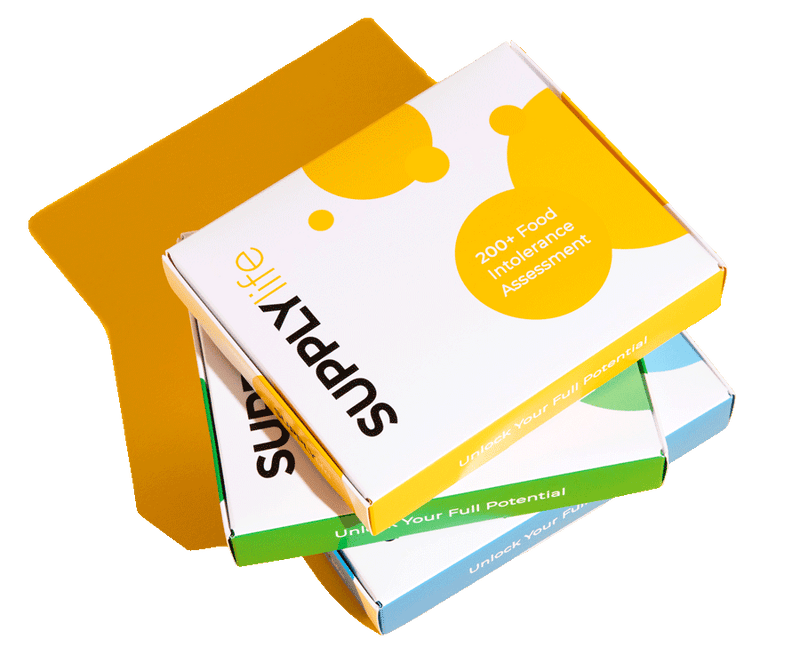
Ricky Singh
Founder of Supply Life
All FAQs
Do food intolerance tests actually work?
Yes, food intolerance tests can be effective in identifying foods that cause adverse reactions. These tests measure IgG antibodies in your blood, which indicate sensitivity to specific foods. Independent studies and clinical practice have shown that eliminating foods identified through these tests can lead to significant symptom relief, especially for conditions like bloating, food related energy dips and others. However, it's important to interpret results with the guidance of a nutritionist / dietician.
Can my GP do a food intolerance test?
An NHS GP's in the UK doesn't offer food intolerance testing, but various GP's around the world do offer a blood based food intolerance test to aid symptoms. Alternatively, there are few blood based CE marked home test kits available that can be used with guidance from a nutritionist to interpret the results accurately.
What is the most accurate food intolerance test?
The most accurate food intolerance tests are those that use blood samples to measure IgG 1,2,3 and 4 antibodies against a wide range of foods using microarray technology. ELISA-based tests are considered reliable and provide detailed insights into food sensitivities. These tests are clinically validated and widely used in medical diagnostics for their precision and reliability.
What is the difference between a food allergy and a food intolerance?
A food allergy (like peanut or shellfish allergy) causes an immediate and often severe reaction such as swelling, rash, or breathing difficulty. This involves IgE antibodies.
A food intolerance usually causes delayed symptoms such as bloating, tiredness, stomach discomfort, or skin issues, which may appear hours or days later. These are often linked to IgG antibodies.
About The Test
Why do you sometimes use the term 'food sensitivity'?
The terms food intolerance and food sensitivity are often used interchangeably. Scientifically, "sensitivity" is more accurate for IgG reactions. At Supply Life, we use "food intolerance testing" because it's widely recognized, but both terms describe the same type of immune response.
What does the Supply Life food intolerance test measure?
Our test measures IgG antibodies to a wide range of foods. High levels suggest that your body may be reacting to those foods.
Why test for IgG food intolerances?
Research and clinical experience show that removing foods linked to high IgG reactions can help improve:
- Digestive issues (IBS-type symptoms)
- Bloating
- Energy levels and fatigue
- Skin health
- Overall wellbeing
Do you test for sugar or alcohol?
No, Supply Life's Food intolerance testing looks at immune reactions to proteins. Sugar and alcohol don't contain enough protein to trigger this kind of reaction. However we do test for brewer's yeast which is contained in beer, wine and some spirits.
What is the test method?
Our food intolerance tests are done using a blood based method covering IgG 1,2,3,4, the blood sample collection process is done via a pin prick to the finger, it takes around 4 - 5 large droplets.
What is the difference between hair and blood based test?
You can't test immune reactions via a hair sample, and in many cases there have been discrepancies in results when parts of the hair have been coloured/bleached. This has led to inconsistency in the sample tested twice.
Our IgG 1,2,3,4 blood based testing covers the full range of antibodies responses, this is important, if a particular food elevates any antibodies against it, this means your gut and immune system recognises that food as a threat. This could affect the nutrients absorbed from this particular food and leads to multiple symptoms. For a detailed comparison, visit our Blood vs Hair Strand Testing page.
Do high IgG antibody levels cause symptoms?
When a food causes the body to produce high levels of IgG then these antibodies combine with the protein in the food to form an 'antigen-antibody complex'. These complexes are usually eliminated by other cells in the immune system. However, if the immune system is overloaded, these insoluble molecules become deposited in tissues within the body, causing chronic inflammation and the subsequent production of symptoms.
Why do food cause an IgG antibodies response?
Generally, foods are broken down during digestion into their component parts e.g. amino acids, glycerides etc. These pass harmlessly through the gut as the gut becomes inflamed (bloated) these proteins enter the bloodstream. This is where they are recognized by the immune system as being 'foreign'. The immune system responds by making IgG antibodies to these foods.
Does Supply Life test for all subclasses of IgG antibody or only IgG4?
Our process screens for all IgG subclasses 1-4, with the numbers on the test report representing the total IgG concentration for each food extract in the selected panel.
Before The Test
What is the lower age limit for testing?
Supply Life's existing policy for a lower age limit on testing for IgG food antibodies is that we do not recommend testing on children under the age of 2 years. We base this on the European Society for Paediatric Gastroenterology, Hepatology, and Nutrition Guidelines for the Diagnosis of Coeliac Disease 2012, which states that there is a possibility of false negative results occurring in infants younger than 2 years of age. This related to the fact that the infant gut is more permeable than that of an adult coupled with immature mucosal immunity that is still in the learning and development stage. We have used this criterion as antibody measurements in Coeliac Disease are comparable to food IgG measurements used in our food intolerance tests. However, we are aware that there are in fact no published guidelines that specifically indicate a minimum age for testing for such IgG antibodies, for example the guidelines for testing for coeliac antibodies indicate that such testing can be performed any time after the introduction of gluten into the diet. Therefore, where such requests are received from a statutory regulated professional the decision of when and what tests to perform will remain the responsibility of the requesting clinician.
Should I avoid testing during pregnancy or breastfeeding?
Yes. Antibody levels are naturally lower at these times, which may affect results. Once you stop breastfeeding we recommend testing after 6 months.
Do I need to eat certain foods before testing?
If you've avoided a food for more than 3 months, it may not show up on the test. If you'd like it checked, reintroduce it daily for a week before testing (unless it causes severe symptoms – in which case, do not reintroduce).
Is there any medication that I should avoid when taking a food intolerance test?
Customers should avoid the use of immunosuppressant medication if possible if performing these tests, as they may have an impact upon the results. Please refer to the medication datasheet in the "Support" section for further details.
Taking The Test
Do you need to fill the microvette all the way to the white line?
Although it is advisable to completely fill the tube, a half filled microvette tube should be enough to run the test. If there are any problems with a sample and the lab will let the customer know. However, if you are ordering two tests we can test from one sample if you provide a full microvette.
Do you need to store the blood in the fridge, if not sending the same day?
Yes, it does need to be stored in the fridge with the lid secured if not sending on the same day.
What are the sample requirements and test turnaround?
A pin-prick blood sample is required. Results are available within 7 working days.
Understanding Results
Do I need to avoid my reactive foods forever?
No. Most people try to avoid them the best they can for 6/9 months, then reintroduce one at a time. If symptoms don't return, you may be able to eat them occasionally.
What if I struggle when I first cut out foods?
This can happen. Some people experience "withdrawal" symptoms for a few days, but most feel better soon after. Our qualified nutritionist can also come up with substitutions for most foods, which will be similar but work better for your body.
How do I book in my call with a Nutritionist and get my tailored meal plan?
These can be booked on your Supply Life profile once you receive your results! All calls and meal plans are made by a qualified nutritionist.
What if I have lots of positive red results?
This may suggest an underlying gut health issue (sometimes called "leaky gut"). We recommend working with our qualified nutrition professional to guide your diet safely and help improve symptoms.
Why do some foods come up more often than others?
Certain foods (like dairy, wheat, and eggs) are more likely to stimulate immune responses, so they appear more often as positives.
Does a positive milk result mean I'm lactose intolerant?
No. Lactose intolerance is caused by an enzyme deficiency. Our test looks at protein reactions in milk, not lactose sugar.
If I test positive for gluten, do I have coeliac disease?
No. Coeliac disease is an autoimmune condition that must be diagnosed by your doctor using specific medical tests. A positive IgG gluten result does not mean you have coeliac disease.
How does the test work?
Food extracts are 'printed' onto nitrocellulose 'pads'™ on a glass microscope slide, together with calibration standards and controls. A blood sample provided by the patient is diluted and dispensed onto each printed microarray. Food IgG antibodies, if present, bind to the food extracts and the results are measured by a high-resolution scanner, before being calibrated against the standards using the reporting software to give quantitative results. This software then produces a tailor-made printout of the final food IgG antibody result for each food on the requested food panel.
Can I upgrade my test to a larger food panel?
You can upgrade for up to a maximum of 4 weeks from the date that your first sample is received.
What are the four symptoms of food intolerance?
The two most common symptoms of food intolerance are:
- Digestive issues (bloating, frequent or infrequent trips to the bathroom)
- Food related energy dips / food coma
However there other many other symptoms that people have reported
No results found. Try a different search term.


